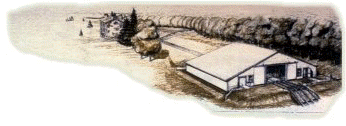|
|
|
 |
|
|
 11.
Incline and reconstructed engine house, Allegheny
Portage Railroad National Historic Site. (Photo:
J. Levin) 11.
Incline and reconstructed engine house, Allegheny
Portage Railroad National Historic Site. (Photo:
J. Levin)
|
|
|
|
|
|
|
In order to build on the
existing interpretive base, much of the initial effort of the
America’s Industrial Heritage project was focused on
existing Park Service units within the nine county region.
Allegheny Portage Railroad National Historic Site was among
the existing Park Service properties which received early
attention. Encompassing several discontinuous tracts of land
in Blair and Cambria counties, the creation of the site was
authorized by Congress in 1964 to preserve and interpret one
of the engineering marvels of the 19th century.
The Pennsylvania Mainline Canal system, of
which the Allegheny Portage Railroad was a key link,
represents an important example of the network of
transportation arteries constructed during the late eighteenth
and early nineteenth centuries. Part of a general interest in
internal improvements, the turnpikes, canals and,
increasingly, railroads contributed to a veritable
transportation revolution (cf. Taylor 1951). These new routes
served as paths for migration and population expansion, and
increased the flow of commodities between the seaboard
population centers and the vast rural hinterland.
The Mainline Canal was completed in early
1833. The eastern portion of the system consisted of a
railroad from Philadelphia to Columbia; a canal then ran from
Columbia to Hollidaysburg, at the base of the Allegheny Front.
The topographic difficulties engendered by the extreme
elevation of the Alleghenies called for a design involving a
combination of rail segments and incline planes. The Allegheny
Portage Railroad consisted of 37 miles of track, traversing
ten incline planes linked by short rail segments. Stationary
steam engines at the head of each plane powered a continuous
rope which hauled rail cars carrying passengers and freight up
the steep inclines. The Portage Railroad served as a link
between the canal terminus at Hollidaysburg and a similar
terminus at Johnstown, on the west side of the Front. A canal
from Johnstown to Pittsburgh completed the system (Shank
1981:13-45).
|

|
|
The National Park Service’s interpretive
center for Allegheny Portage Railroad National Historic Site
is located at the Summit Level. Situated at the head of Plane
6, at the highest point on the portage system, the Summit
Level park unit includes a portion of the Portage Railroad
trace, the foundation remains of Engine House #6, and a large
stone building contemporaneous with the railroad.
Samuel Lemon, a local tavern keeper, erected
this substantial structure, which is today known as the
Lemon House, sometime around the year 18343.
The building stood adjacent to the level, just above the
head of the incline, with the front door a scant 100 feet
from the tracks. By 1839 Lemon was in business as a coal
dealer as well as a tavern keeper (Toogood 1972:47). A
map, dated 1840, indicates that a mine entrance and a
coal wharf were located directly across the tracks from
the front door of the Lemon House (Toogood 1972:9).
|
|